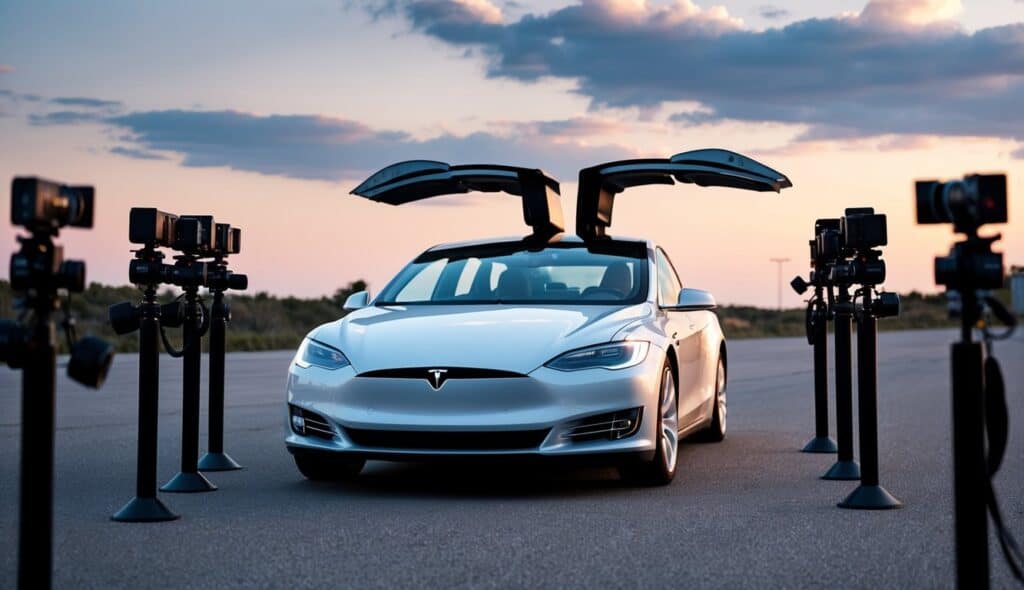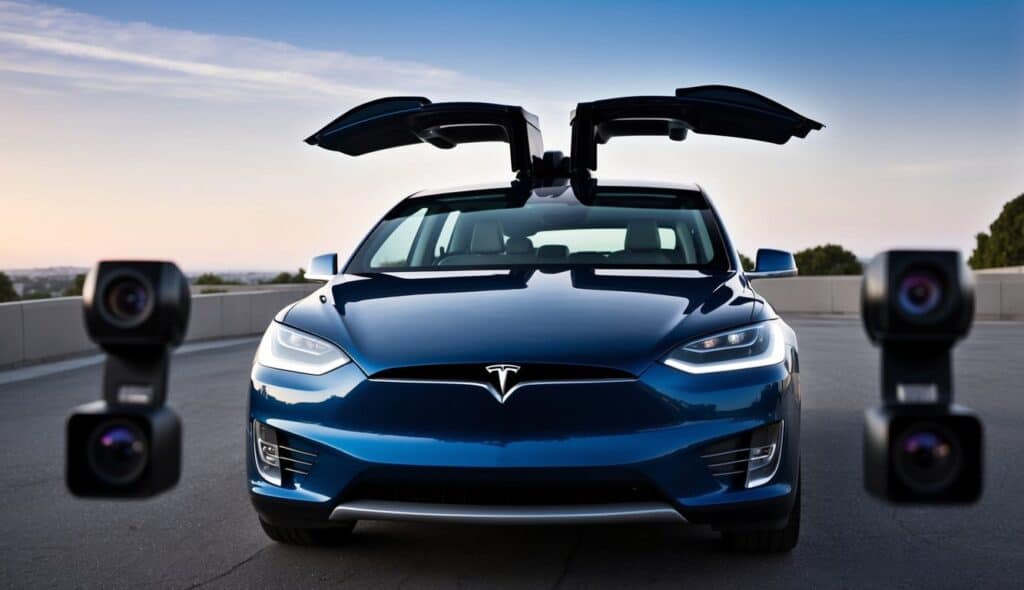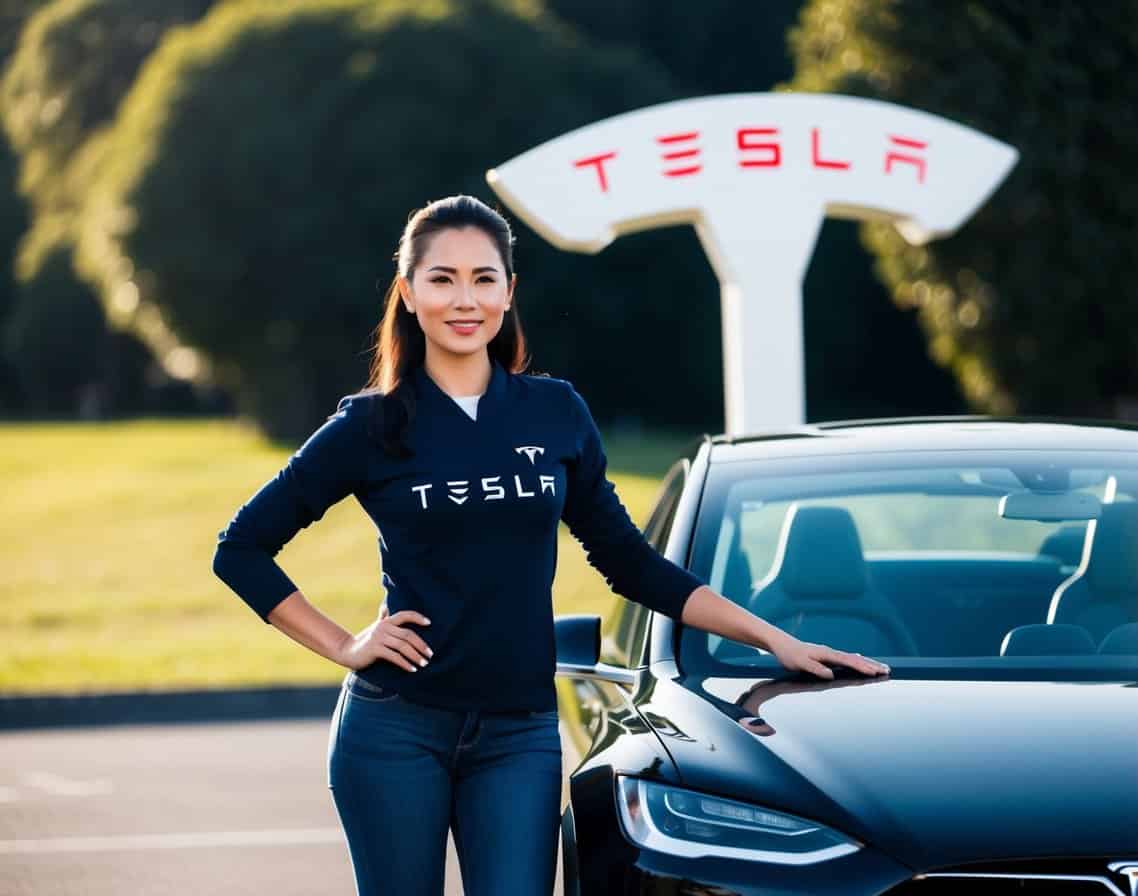Tesla vehicles are equipped with an impressive array of cameras that enable advanced safety and autopilot features. These cameras serve as the car’s eyes, constantly monitoring its surroundings and providing crucial data to its computer systems.
Current Tesla models have nine cameras in total: eight exterior cameras and one interior camera. The exterior cameras are strategically placed around the vehicle to provide a 360-degree view of the environment.
They include three forward-facing cameras mounted at the top of the windshield, two side cameras on the front fenders, two side cameras on the B-pillars, and one rear-facing camera.
The cameras work together to support Tesla’s Autopilot system, enhance safety features, and provide security functions.
They can detect other vehicles, pedestrians, road signs, and potential obstacles. This camera setup is a key part of Tesla’s innovative approach to vehicle technology, setting the brand apart in the automotive industry.
Tesla’s Approach to Vehicle Safety
Tesla’s safety strategy centers on cameras. These cameras work with advanced software to protect drivers and passengers. They also help the car drive itself in some situations.

Significance of Cameras in Safety Features
Tesla cars use multiple cameras to monitor the road and the area around them. These cameras can spot dangers that humans might miss. They help prevent crashes by warning drivers or taking action if needed.
The cameras also record what happens near the car when it’s parked. This feature, called Sentry Mode, scares away thieves and catches vandals.
Tesla’s cameras do more than just look around. They feed data to the car’s computer, allowing the car to make quick choices to keep people safe.
The cameras can see in all directions at once, which is better than what a human driver can do.
The Role of Autopilot in Enhancing Security
Autopilot is Tesla’s driver assistance system. It uses the car’s cameras to steer, speed up, and slow down independently, helping prevent accidents caused by human error.
Autopilot can keep a safe distance from other cars and stay in its lane. The system can also change lanes and take highway exits, all while watching for other vehicles and obstacles.
Autopilot isn’t perfect, so drivers still need to pay attention. But it adds an extra layer of safety to every trip.
Tesla keeps improving Autopilot with updates. These updates often use data from the cameras of Tesla cars on the road, helping make the system smarter and safer over time.
Understanding Tesla’s Camera System
Tesla cars use a sophisticated camera system for safety and autonomous driving features. The setup includes multiple cameras placed strategically around the vehicle to provide a complete view of the surroundings.
Eight Cameras Architecture
Tesla’s current models have eight exterior cameras positioned to cover all angles around the car.
The front has three cameras: a primary camera, a wide-angle lens, and a narrow-angle lens.
Two cameras, one facing forward and one facing backward, are mounted on each side of the vehicle. These help with blind spot detection and lane changes.
A rear-facing camera aids in parking and backing up. The final camera is mounted above the rear license plate, providing an additional view behind the car.
This eight-camera setup gives Tesla vehicles a 360-degree view of their environment, crucial for Autopilot and Full Self-Driving features.
Cabin Camera for Driver Monitoring
Tesla has added an interior cabin camera in newer models. This camera is located above the rearview mirror and faces the driver.
Its main purpose is to monitor driver attentiveness when Autopilot is engaged. The camera can detect if a driver’s eyes are closed or not focused on the road.
Tesla says this camera improves safety by ensuring drivers remain alert while using assisted driving features. The cabin camera data is not linked to the car’s identification number and is not transmitted unless the driver opts in.
Integration with Tesla Vision
Tesla Vision is the company’s camera-based driver assistance system. It relies solely on cameras and neural network processing, eliminating the need for radar.
The system uses the eight exterior cameras to detect objects, lane markings, and traffic signs. It can identify other vehicles, pedestrians, and road hazards.
Tesla Vision processes these camera inputs in real-time to make driving decisions. This system powers features like Autopilot, Navigate on Autopilot, and Smart Summon.
The integration of cameras with Tesla Vision allows for constant improvements through over-the-air software updates, enhancing the car’s capabilities over time.
Tesla Models and Their Camera Specifications
Tesla cars use cameras to enable features like Autopilot and Full Self-Driving. The number and placement of cameras varies between models. Recent Tesla vehicles have eight external cameras and one interior camera.
Model 3 and Model Y Camera Details
The Model 3 and Model Y share the same camera setup. They have nine cameras total:
- 3 forward-facing cameras on the windshield
- 2 forward-looking side cameras on the front fenders
- 2 rearward-looking side cameras on the B-pillars
- 1 rear-facing camera above the license plate
- 1 cabin-facing camera near the rearview mirror
These cameras work with 12 ultrasonic sensors to provide a 360-degree view around the car. The system helps with parking, lane-keeping, and collision avoidance.
Model S and Model X Camera Features
The Model S and Model X also use nine cameras. The camera layout is similar to the Model 3 and Model Y:
- 3 front-facing cameras
- 2 side cameras on front fenders
- 2 side cameras on B-pillars
- 1 rear camera
- 1 interior camera
Newer Model S and X cars (2021 refresh and later) have upgraded cameras. These offer better image quality and low-light performance and support Tesla’s Full Self-Driving system.
Camera Capabilities in Cybertruck and Roadster
The Cybertruck and new Roadster are not yet in production, and Tesla has not released the final camera specs for them.
They will likely use at least eight external cameras, like other recent Tesla cars. The Cybertruck may need extra cameras due to its large size. Possible additions could include:
- Cameras to help with towing
- Side cameras for better visibility
- Cameras to assist with off-road driving
The Roadster might have cameras tailored for high-speed driving and track use. As Tesla’s top performance car, it could feature advanced camera tech not found in other models.
Auxiliary Safety and Assistance Features
Tesla cars use cameras and other sensors to provide advanced safety and driving assistance. These systems work together to enhance the driving experience and protect passengers.

Role of Radar and Ultrasonic Sensors
Tesla vehicles use radar and ultrasonic sensors to complement their camera systems.
Radar helps detect objects in front of the car, even in poor visibility. It can see through rain, fog, and snow.
Ultrasonic sensors are placed around the car’s body. Most Tesla models have 12 of these sensors. They detect nearby objects for parking and low-speed maneuvering.
These sensors give the car a more complete view of its surroundings. They work with cameras to create a detailed picture of the environment.
Implications of Adaptive Cruise Control
Adaptive Cruise Control (ACC) is a key feature in Tesla cars. It uses cameras and radar to maintain a safe distance from other vehicles.
ACC adjusts the car’s speed automatically. It slows down when approaching a slower car and speeds up when the road is clear.
This system reduces driver fatigue on long trips. It also helps prevent rear-end collisions by keeping a safe following distance.
Autosteer and Summon Functionalities
Autosteer is part of Tesla’s Autopilot system. It uses cameras to keep the car centered in its lane. The system can handle gentle curves on highways.
Drivers must keep their hands on the wheel when using Autosteer. It’s not a fully autonomous driving feature.
Summon lets owners move their Tesla remotely using a smartphone app. The car uses its cameras and sensors to navigate parking lots.
This feature is helpful for tight parking spaces. It can also bring the car to its owner in a parking lot.
Impacts of Automation on Driver Experience
Tesla’s automation features change how drivers interact with their vehicles. These systems aim to boost safety and ease of use through enhanced sensing and control capabilities.
Enhancing Visibility and Detection
Tesla cars use multiple cameras to give drivers a better view of their surroundings. The system can spot obstacles, read road signs, and track other vehicles, helping drivers stay aware of potential hazards.
Automation also aids in tricky driving situations. It can assist with parallel parking and navigate tight spaces.
The car’s sensors work together to create a 360-degree view around the vehicle.
Automated systems can enhance visibility at night or in bad weather. They use special cameras and sensors that work well in low light, giving drivers an edge when human eyes might struggle to see clearly.
Transition to Full Self-Driving
Tesla is working towards Full Self-Driving (FSD) capabilities. Current systems require active driver supervision. They can handle some tasks but aren’t fully autonomous yet.
As automation improves, drivers may need to stay alert in new ways. They must be ready to take control if the system needs help. This shift changes the traditional driving experience.
Tesla updates its software regularly to add new features. Drivers may wake up to find their car can do more than it could the day before. This ongoing evolution keeps the driving experience fresh and exciting.
The path to Level 5 autonomy, where cars can drive themselves in all conditions, is still being developed. Each step brings new benefits and challenges for drivers to adapt to.
The Future of Tesla’s Camera Technology
Tesla keeps pushing the limits of camera tech in cars. Their plans could change how we see and use vehicles.

Innovations in Camera Development
Tesla is working on new camera designs. They want better image quality and wider views.
The company may add more cameras to cars, which could help them spot objects farther away or in tough spots.
Tesla might use AI to make cameras smarter. This could help cars understand their surroundings better.
The cameras could work better at night or in bad weather.
Elon Musk has hinted at plans for improved cameras. These may have higher resolution and faster processing.
This could make self-driving features work even better.
Prospects for Security and Privacy
As Tesla adds more cameras, it needs to think about security. They must protect the data these cameras collect.
Tesla is likely working on strong encryption for video feeds.
Privacy is a big concern with car cameras. Tesla may add features to let drivers control when cameras are on.
They could also limit what the cameras record in certain places.
Some worry about hackers accessing Tesla cameras. The company will need to keep improving its cybersecurity.
They may partner with experts to make their systems safer.
Notable Dimensions and Technical Details
Tesla vehicles utilize multiple cameras strategically placed around the exterior. These cameras provide comprehensive coverage and enable key safety and autonomous driving features.
Analyzing Camera Placement and Coverage
Tesla cars have 8 external cameras. Three face forward from the windshield area – a main camera, wide-angle camera, and narrow-angle camera.
Side cameras are mounted on each front fender and B-pillar. A rear-facing camera sits above the license plate.
This setup gives nearly 360-degree visibility around the vehicle. The front cameras can see up to 250 meters ahead for highway driving.
Side cameras monitor adjacent lanes and blind spots. Rear cameras assist with parking and backing up.
Specifications of Camera Resolution and Field of View
Tesla cameras use high-resolution sensors to capture detailed images. The primary forward camera has a 50-degree field of view.
The wide-angle camera spans 150 degrees for a broader view, while the narrow camera’s 35-degree field helps with long-range detection.
The side cameras monitor adjacent lanes with a 90-degree field of view, while the rear camera provides a 150-degree view behind the car.
Tesla Vision software combines camera data to build a 3D model of the car’s surroundings.
These cameras enable features like Autopilot, Sentry Mode, and the built-in dashcam. The system can detect and classify objects, read road signs, and navigate complex driving scenarios.
Conclusion
Tesla vehicles come equipped with an array of cameras. Most current models feature nine cameras in total.
Eight cameras are positioned around the exterior of the car. These provide a 360-degree view of the surroundings.
The ninth camera is located inside the cabin. This internal camera serves various functions related to driver monitoring and safety.
Tesla’s camera system plays a crucial role in enabling advanced features, including Autopilot and Full Self-Driving capabilities.
The cameras work together to gather visual data about the environment.
This multi-camera setup allows Tesla vehicles to perceive their surroundings in detail. It helps with tasks like lane keeping, obstacle detection, and parking assistance.
The camera system has evolved. Tesla continues to refine and improve its visual perception technology.
This ongoing development aims to enhance safety and autonomous driving features.

Hi, I’m Marybeth, an electric car enthusiast living in New York in the USA. As the owner of electriccartalks.com, I love sharing my knowledge on EV tips, battery maintenance, and charging solutions. As a proud Tesla owner, I blend my personal experiences with professional insights to offer valuable information to fellow EV enthusiasts. Through my articles, I aim to empower others to make informed decisions about their electric vehicles. Read more